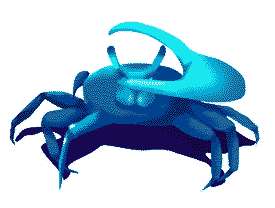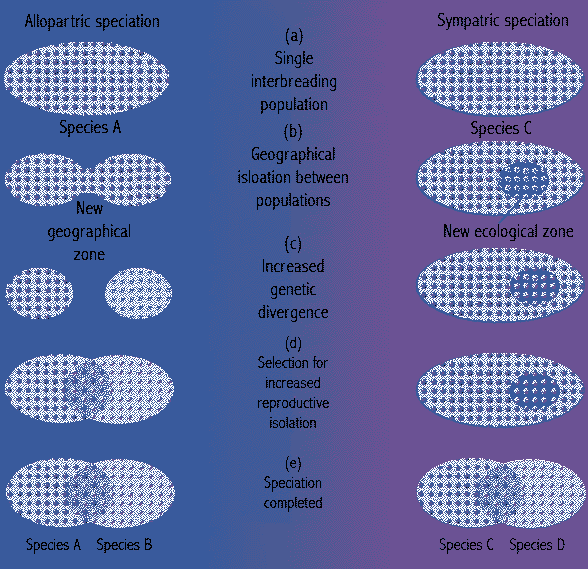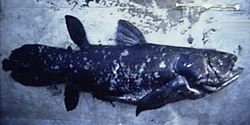What Factor Can Cause to Two Populations to Become Reproductively Isolated
| The Process of Speciation | Every individual alive today, the highest also as the lowest, is derived in an unbroken line from the start and lowest forms. From the remotest past which Science tin can fathom, upward to the novelties of yesterday, that in which Progress essentially consists, is the transformation of the homogeneous to the heterogeneous. |
| 02/13/02 | |
In this lesson, we wish to ask:
- What is biological evolution?
- How are theories of microevolution and macroevolution related?
- What is a species, and what are the dissimilar ways it can be defined?
- What are the limitations of each definition?
- How is reproductive isolation important to speciation, and what forms tin information technology have?
- Why should natural choice reinforce reproductive isolation?
- Can species be formed in ways other than geographic isolation?
Evolution and Its Many Forms
Today we keep a iii-lecture sequence on biological, or organic, evolution. Development is a unifying theme of this course, and the concept of evolution is relevant to many of our topics.The word "evolution" does not use exclusively to biological evolution. The universe and our solar system accept developed out of the explosion of matter that began our known universe. Chemical elements accept evolved from simpler matter. Life has evolved from non-life, and complex organisms from simpler forms. Languages, religions, and political systems all evolve. Hence, evolution is an appropriate theme for a class on global modify.
The cadre aspects of evolution are "change" and the role of history, in that past events take an influence over what changes occur subsequently. In biological evolution this might mean that complex organisms arise out of simpler ancestors - though be aware that this is an over-simplification not acceptable to a more advanced discussion of evolution.
A full give-and-take of development requires a detailed caption of genetics, because science has given u.s. a proficient agreement of the genetic footing of development. It as well requires an investigation of the differences that characterize species, genera, indeed the entire tree of life, because these are the phenomena that the theory of evolution seeks to explicate.
We will begin with observed patterns of similarities and differences amid species, because this is what Darwin knew about. The genetic basis for evolution just began to exist integrated into evolutionary theory in the 1930'southward and 1940's. We will add together genetics into our understanding of evolution through a discussion activity.
Definitions of Biological Evolution
Nosotros begin with two working definitions of biological evolution, which capture these 2 facets of genetics and differences amongst life forms. Then nosotros will ask what is a species, and how does a species arise?- Definition 1:
- Definition ii:
Changes in the genetic composition of a population with the passage of each generation
The gradual change of living things from one form into another over the course of fourth dimension, the origin of species and lineages past descent of living forms from bequeathed forms, and the generation of variety
A full explanation of evolution requires that we link these 2 levels. Can small, gradual change produce singled-out species? How does it occur, and how do we make up one's mind when species are species? Hopefully you lot will see the connections by the cease of these three lectures.
Today we volition hash out how species are formed. But to do this, we need to define what we are talking about.
What is a Species?
Despite our increasing ability to empathise the finest details of organisms, there is still debate about what constitutes a species. Definitions of species tend to fall into 2 master camps, the morphological and the biological species concepts.- Morphological species concept: Oak trees look like oak trees, tigers wait like tigers. Morphology refers to the form and construction of an organism or any of its parts. The morphological species concept supports the widely held view that "members of a species are individuals that look similar to 1 another." This school of thought was the ground for Linneaus' original classification, which is still broadly accepted and applicable today.
Mimicry complexes supplied further evidence against the concept, as organisms of the same species can expect very unlike, depending upon where they are reared or their life cycle stage (some insects produce a jump brood that looks like one host constitute and a summer brood that looks like some other).
The morphological species concept was replaced by another viewpoint that puts more emphasis on the biological differences betwixt species.
- Biological species concept: This concept states that "a species is a grouping of actually or potentially interbreeding individuals who are reproductively isolated from other such groups."
This concept also emphasized that a species is an evolutionary unit of measurement. Members share genes with other members of their species, and not with members of other species.
Although this definition clearly is attractive, it has problems. Can you lot test it on museum specimens or fossil data? Tin can it explain the existence of species in a line of descent, such equally the well-known lineage of fossil horses? Apparently not.
In fact, i cannot utilise this definition hands, or at all, with many living organisms. What if species do not live in the aforementioned place? What nearly the hybrids that we know occur in zoos? These problems are serious enough that some biologists recently argued for a return to the morphological species concept.
So what is the best way to define a species?
Most scientists feel that the biological species concept should be kept, but with some qualifications. Information technology can only be used with living species, and cannot always be practical to species that practice not live in the same place. The real exam applies to species that have the potential to interbreed.
Most chiefly, the biological species concept helps usa ask how species are formed, considering it focuses our attention on the question of how reproductive isolation comes about. Let us offset examine types of reproductive isolation, because there are quite a few.
Types of Reproductive Isolation
In that location are many barriers to reproduction. Each species may have its own courtship displays, or breeding season, so that members of the two species do not have the opportunity to interbreed. Or, the two species may be unable to interbreed successfully considering of failure of the egg to go fertilized or to develop.This suggests a uncomplicated and useful dichotomy, between pre-mating or prezygotic (i.due east., pre-zygote formation) reproductive isolating mechanisms, and post-mating or postzygotic isolating mechanisms. Retrieve that a zygote is the cell formed past the union of two gametes and is the basis of a developing individual.
Prezygotic isolating mechanisms
- Ecological isolation: Species occupy different habitats. The panthera leo and tiger overlapped in Bharat until 150 years ago, only the lion lived in open grassland and the tiger in wood. Consequently, the ii species did not hybridize in nature (although they sometimes do in zoos).
- Temporal isolation: Species breed at unlike times. In North America, five frog species of the genus Rana differ in the fourth dimension of their pinnacle breeding activity.
- Behavioral isolation: Species engage in distinct courtship and mating rituals (come across Effigy one).
- Mechanical isolation: Interbreeding is prevented by structural or molecular blockage of the germination of the zygote. Mechanisms include the disability of the sperm to demark to the egg in animals, or the female reproductive organ of a plant preventing the wrong pollinator from landing.

 | Postzygotic isolating mechanisms
** Postal service-zygotic mechanisms are those in which hybrid zygotes fail, develop abnormally, or cannot cocky-reproduce and plant viable populations in nature. ** And so species remain distinct due to reproductive isolation. Simply how do species form in the offset place? An abbreviated illustration of meiosis, past which reproductive cells duplicate to grade gametes. |
 |
Species Germination
How practice nosotros get cladogenesis -- the splitting of i lineage into two?This question is disquisitional, because it is what produces many species from few, and results in evolutionary trees of relatedness. The near common manner for species to split, especially in animal species (we will talk more about the origin of new plant species after), is when the population becomes geographically isolated into two populations. This is referred to as allopatric (geographic) speciation (see Figure).
 |
| 1 model of allopatric speciation. A unmarried population (a) is fragmented by a barrier (b); geographical isolation leads to genetic divergence (c); when the barrier is removed, the two populations come dorsum into contact with each other, and at that place is selection for increased reproductive isolation (d); if reproductive isolation is effective, speciation is consummate (east). |
Geographic isolation leads to reproductive isolation. Once two populations are reproductively isolated, they are free to follow different evolutionary paths. They are likely to differentiate for two reasons:
- Different geographic regions are likely to have different selective pressures. Temperature, rainfall, predators and competitors are likely to differ between two areas 100's or 1,000'south of kilometers apart. Thus, over time, the ii populations will differentiate.
- Even if the environments are not very different, the populations may differentiate considering different mutations and genetic combinations occur by chance in each. Thus, pick will take unlike raw material to act upon in each population.
Differentiation also depends upon the forcefulness of selective pressures. Strong option can cause rapid alter.
Given time and selection, the 2 populations become 2 species. They may, at some subsequently time, spread back into contact. Then we can enquire, are these two "good biological species"?
The existent test of the biological species concept is when two populations, on the threshold of condign ii species, come up back into contact. They may but merge. They may be and so different that they practice not fifty-fifty recognize one another equally species.
Often, though, species may come up into contact when not however fully reproductively isolated. In that event, natural selection should reinforce the reproductive barriers. Why? Considering individuals that waste their reproductive try -- their gametes -- on individuals with whom they will produce inferior offspring are less probable to pass on their genes to the next generation.
Natural selection should reinforce reproductive isolation. Probably, species that are isolated only past mail-zygotic barriers will subsequently evolve pre-zygotic barriers. Why should that occur?
To review: allopatric (geographic) speciation is the differentiation of physically isolated populations to the indicate that reunion of the 2 populations does not occur if contact is re- established.
Speciation as a Gradual Process
Our understanding of speciation arising from reproductive isolation and the gradual evolution of reproductive isolating mechanisms should assistance the states to capeesh why the biological species concept, and the test of reproductive isolation, may sometimes fail.If speciation is a gradual process, species may not yet be fully separated. A continuum must exist from species that are in the process of splitting into 2, to species that are fully formed. Surely nosotros merely expect the latter to behave as "good species."
We nevertheless oasis't fully explained the speciation process. In our side by side lesson, we will examine the theory of natural option, which helps to explain how localized populations get adapted to local atmospheric condition. By adapting to local conditions and accumulating genetic differences, isolated geographic races start downwards the path to becoming divide species and creating another pair of branches on the tree of life.
Only at present I want to point out that at that place are alternative models of species formation, and finally I desire to conclude by linking the concept of species formation to the hierarchical structure of life.
Alternative Models of Species Formation -- Hybridization and Polyploidy
In plants, new, reproductively isolated species may arise instantaneously, due to multiplication of the unabridged complement of chromosomes by a process known equally polyploidy. This may occur as a result of hybridization, combining the chromosome sets from two parent species in a hybrid individual. If such hybrids plough out to be well adapted to environmental conditions, hybridization is a mechanism that produces new species.Even if hybrids are unable to undergo sexual reproduction considering their chromosomes do not sort out properly in meiosis, they may reproduce vegetatively. The full chromosome number also may double by combining the chromosome sets of a single species.
Of the 260,000 known species of plants, equally many as half may have originated in this way. Many commercially important plants are examples of polyploidy (e.one thousand. bread wheat, cotton fiber, tobacco, sugar cane, bananas, potatoes). Polyploidy is an case of sympatric speciation defined as species arising within the same, overlapping geographic range.
Conclusion: Species Germination and the Hierarchy of Life
Speciation results in the splitting of an bequeathed species into ii (or more) descendent species. This procedure, connected indefinitely, results in a sequence of speciation events extending over great expanses of time, resulting in a branching tree of historical relatedness. Imagine if nosotros had consummate and certain knowledge of such a tree -- it would tell us the evolutionary relatedness among living things, the pathways of departure, even the timing of separation.There are 2 ways to construct a phylogenetic tree (meet Figure). Nosotros can use a "perfect" fossil tape to trace the sequence from start to end, or we can use similarities and differences among living things to reconstruct history, working from the endpoint toward the beginning.

In this course, nosotros will not consider these ii methods in detail. I introduce them to brand the point that, ultimately, nosotros want to empathise how evolution produces not merely two species from one simply the entire tree of life. This requires that we make the transition from microevolution to macroevolution. To Darwin, and to modern evolutionary biologists also, the respond simply is time. Given enough time and successive splittings, the processes that produce two species from one will result in the entire diversity of life.
In reality, deducing the historic tape of branching is very difficult. Information are incomplete, scientists argue the pace of modify, and sometimes species separated by many branching steps look more than like to one another than those separated past one or a few branches. Molecular biological science offers exciting new opportunities to accost these issues, by looking at similarities and differences in DNA sequences.
From here nosotros will turn abroad from the macroevolutionary view and look more closely at how small changes occur and accumulate, by the processes of natural choice and genetic alter.
Summary
Biological evolution tin be defined in 2 means: as a result of changes in the genetic composition of a population with the passage of each generation (microevolution), or as a result of the gradual change of living things from one class into another over the course of fourth dimension, generating species diversity (macroevolution).The definition of a species is debatable. Most scientists adhere either to the morphological species concept (members of a species look alike and can be distinguished from other species by their appearance), or to the biological species concept (a species is a group of actually or potentially interbreeding individuals who are reproductively isolated from other such groups). Both definitions have their weaknesses.
Reproductive isolating mechanisms are either prezygotic or postzygotic. These mechanisms ensure that species remain distinct in nature.
Species formation can occur either through allopatric (geographic) speciation or through sympatric speciation.
We tin can construct phylogenetic trees that show the evolutionary relatedness among living things, though the edifice of such trees is as yet an imperfect science.
Suggested Readings:
- Futuyma, D.J. 1986. Evolutionary Biological science. Sunderland, Mass: Sinauer Associates, Inc.
- Wessells, N.One thousand. and J.L. Hopson. 1988. Biology. New York: Random House. Chapter 43.
- Rosenzweig, M.L. 1995. Species Variety in Infinite and Time. Cambridge: Cambridge Academy Press.
Copyright Regents of the University of Michigan unless noted otherwise.
Source: https://www.globalchange.umich.edu/globalchange1/current/lectures/speciation/speciation.html

Post a Comment for "What Factor Can Cause to Two Populations to Become Reproductively Isolated"